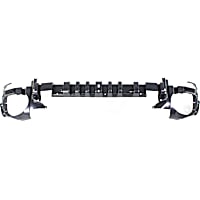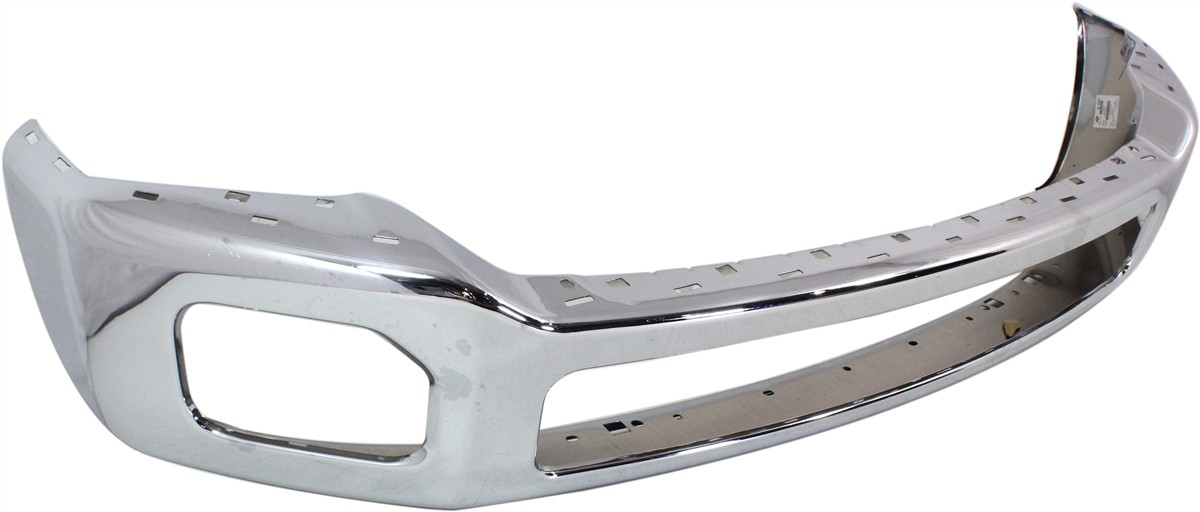Most people who don’t know much about vehicles would probably find it confusing when they encounter the term, “bumper cover.” Is that different from a bumper? What is it used for?
It can be hard for people to differentiate between bumpers versus bumper covers. However, not knowing the difference can lead you to purchase the wrong part—so once and for all, let’s clear up the confusion by covering the nuances between these two vehicle components.

What is a Bumper?
Decades ago, a bumper was a solid metal component affixed to the front of a vehicle. But nowadays, that’s not usually the case. While most people assume the bumper is the visible, front fascia of a modern car, it’s actually a hidden structure behind the bumper cover. Only a few applications, such as heavy-duty pickup trucks, still employ a visible bumper.
Bumpers of all varieties are designed to absorb some impact in a collision, which means they act as a barrier between your vehicle and the other vehicle (or object) involved in the accident. This ensures that some of the more important components under the hood receive less of the impact, thereby mitigating your repair costs.
Modern bumpers, in particular, are designed to absorb minor dings and low-speed impacts. Behind the bumper (also known as a bumper reinforcement), you’ll find energy absorbers.
What is a Bumper Cover?
On the other hand, the bumper cover (also known as the front fascia) is a visible, molded body component that’s typically made out of either plastic or fiberglass. This is the part of the front end that people often misidentify as the bumper itself.
The bumper cover sits in front of the actual bumper. Basically, the bumper cover is there to provide a kind of aesthetic appeal that is unobtrusive. Bumper covers also enhance aerodynamics and, thereby, improve fuel efficiency.
The Differences Between a Bumper Cover and a Bumper
Here’s a comparison table to show you the key differences between a bumper and a bumper cover:
| Attributes | Details | |
|---|---|---|
| Bumpers | Bumper Covers | |
| Functionality | The bumper is a structural component designed to absorb impact in the case of a front-end collision. |
The bumper cover is the soft (usually modeled plastic) portion of your car designed to add aesthetic appeal and enhance aerodynamics. |
| Protection | As mentioned above, these offer decent protection against impact, as well as a contribution to your car’s “crumple zone”*. |
Covers are just that—covers. They’re aesthetic fittings that offer little to no protection on their own. |
| Materials | Metal or special grade alloys. | Can range from high-density plastic materials, fiberglass, and rubber to synthetic and genuine leathers. |
| Availability | This will depend on your car’s year, make, and model, as you will have to purchase one that fits your car perfectly. |
Same as bumpers |
*The crumple zone is a vehicle safety feature that easily deforms and collapses in case of a collision, absorbing some of the energy of the impact and preventing it from being transmitted to the passenger cabin and everyone inside it.

When Should You Get a Bumper Cover?
It’s usually up to your discretion on whether to get either your front bumper cover or rear bumper cover replaced. However, if you need further justification, here are some reasons why you may need a new bumper cover:
- “The paint was chipping away” – The paint job of your car, however resilient, may get damaged by the elements over time. When this happens, the paint either dries up due to the heat or creates air bubbles due to the humidity. If you see your bumper cover showing signs of damage, it might be time to purchase a new one.
- “That old bumper was deteriorating” – Deterioration can mean a lot of things. An object can physically deteriorate, but what you may say here is that it’s “aesthetically deteriorated” or, in simpler terms, you find that a change in appearance is needed for your car.
- “It had a lot of dents already anyway” – While dents don’t always equate to relevant damage, they can be visually displeasing. If you’re tired of looking at your dented bumper cover, this reasoning would be justification enough to get that shiny new bumper cover that you’ve been eyeing.
Here’s a helpful video on how to replace your front bumper cover:
When Should You Get a Bumper?
Bumpers, on the other hand, are much easier to justify purchasing. This is due to the fact that while bumper covers may be replaced for aesthetic purposes, bumpers are really there to help minimize damage (and as a result, passenger injury) after a nasty accident or collision.
Hence, the only consideration in purchasing a bumper is whether or not it is still functional after a collision. What you have to know is that if your bumper is damaged from an accident, you’ll need to replace it as soon as you can, and chances are, some other parts of your car may require replacement as well.
Before you purchase either a replacement bumper cover or bumper, it’s important to check that it’s CAPA-certified. The Certified Automotive Parts Association (CAPA)—which is recognized by the entire automotive industry—is an independent authority that assesses the fit, quality, and safety of replacement parts to the highest standards. If you choose a CAPA-certified bumper or bumper cover, you can rest assured that it’s passed stringent crash tests, which means ultimate peace of mind for you and your passengers.

Watch these videos to understand how to replace your front and rear bumpers:
I Found the Perfect Bumper Cover. Now What?
After finding the best bumper cover (or replacement bumper) for your vehicle in our catalog of auto parts, it’s time to order it and have it delivered to you. Shipping costs can be quite costly. Fortunately, you won’t have to worry about delivery fees for our products if you have a CarParts+ membership.
CarParts+ offers excellent benefits, including free shipping. This means you’ll get easy access to 500,000 unique parts – all of which are ready to be delivered right to your doorstep.
You’ll also get access to other exclusive perks such as VIP Customer Service, 24/7 Roadside Assistance, and Extended Returns. Sign up today to have that extra confidence on the road.
Products Mentioned in this Guide
Shop this Project




Any information provided on this Website is for informational purposes only and is not intended to replace consultation with a professional mechanic. The accuracy and timeliness of the information may change from the time of publication.


 Bumper Cover
Bumper Cover
 Bumper
Bumper
 Bumper Reinforcement
Bumper Reinforcement
 Bumper Absorber
Bumper Absorber

































I have a 2012 Venza. The situation I have is. My rear bumper. A trailer came off the hitch and hit the lower middle of my bumper. Where do I find the right part and can I repair it myself.
I had s trailer come off hitch. It didn’t do much damage, however it punch a hole in the bottom middle of my bumper. It appears that it’s a one piece rear bumper. What do I need to do and can I fix it myself. Please help.
half of my bumper came off, is it ok to just get a bumper cover because the actual bumper is a lot more expensive
Hello Brittany,
The bumper is a structural part of the vehicle that should be replaced if damaged.
I have a 2021 subaru impreza. I hit a pothole and cracked the left bottom of my bumper. Can I just get a cover or should I replace the whole thing. I see bumpers going for 800 when covers are only 170
Hello,
The bumper is the actual structural component behind the bumper cover. If that is damaged, you should replace it. Otherwise, you can just replace the bumper cover.
Someone bumped my rear bumper trying to get out of a parking spot. The bumper cover is cracked and has a hole. If I’m ok with the cosmetics, do I need to have the bumper cover fixed?
Hello,
If only the bumper cover was damaged (and none of the structural components behind it) and the cover is still safely secured to your vehicle, you shouldn’t need to replace it except for cosmetic reasons.